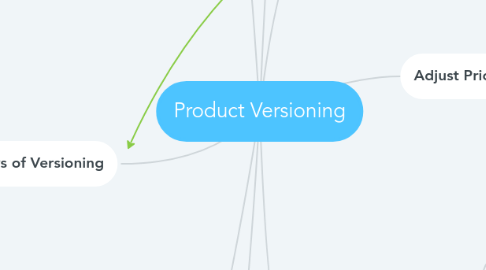
1. Ways of Versioning
1.1. User Interface: provide high-paying customers w/ more powerful search capabilities
1.1.1. more experienced =more intense usage of information = more willingness to pay
1.1.1.1. little to no extra cost for company to offer the extra capabilities between users!
1.1.2. smart design - more in-depth and advanced design for more intense users
1.2. Delay: key to versioning information is delaying before offering less expensive versions.
1.2.1. "Info is like an oyster: it has the greatest value when fresh"
1.2.2. customers differ in how eager they are to attain a certain type of info
1.2.3. works for services, products, and other types of information
1.3. Convenience: version information by restricting it by time or place at which it is used
1.4. image resolution: professionals want higher-resolution
1.5. Speed of Operation: offer different levels of speeds for a service
1.6. Flexibility of Use: ability to store, duplicate, or print the information.
1.6.1. Ex) some goods are protected to prevent the spreadability
1.7. Capability: high-end market segments willing to pay for enhanced capabilities.
1.8. Features & Functions: basic vs. premium versions of information goods & services.
1.9. Comprehensiveness: scholars and highly interested consumers are willing to pay extra for complete, in-depth, and historically patterned information.
1.10. Annoyance: shareware that's distributed freely but displayed at start & end of session encouraging you to pay registration fee (nagware).
1.10.1. ex) Spotify Premium advertising before and after playing songs on basic Spotify
1.11. Support: offer technical support to customers.
1.11.1. Risks: Customers don't end up liking your product, costly for company, bad public relations risk if promise is not met
2. Pitfalls
2.1. emphasize that cheaper versions enhance consumer choice. They value low-end version at a discount.
2.2. make sure users can't easily turn the low-end version into high-end
3. Bundling
3.1. form of versioning in which 2+ distinct products are offered as a package at a single price
3.2. offers bundle to customers who would buy the other product at smaller incremental price than the stand-along price.
3.3. useful for introducing new products to consumers
3.4. online bundling: subscriptions of magazine or newspaper bundles
3.5. Customized Bundles - reduced dispersion in willingness to pay by offering exactly how they want it.
4. lecture 3: online display advertising
4.1. messages are not restricted by time or place.
4.2. can be perceived to be less disruptive
4.3. more interactive than offline
4.4. types of display advertising
4.4.1. banner
4.4.2. wallpaper
4.4.3. map
4.4.4. pop-ups & unders
4.4.5. floating
5. offer a product line & let users choose version most appropriate for them
5.1. self-selection: customer reveals value through version they select
5.2. Design product line to maximize profit from information you're selling... Affected by:
5.2.1. total value you create for customers
5.2.2. fraction of that value which you're able to extract through fees you charge for info
6. Value-Based Pricing Approaches
6.1. Personalized Pricing
6.1.1. sell to each user at different price
6.1.2. "best intelligence about consumers comes directly from them"
6.2. Product Versioning
6.3. Group Pricing
6.3.1. set different for different groups of consumers ex) student price
6.4. value-based: adjust price to diff people depending on what they're willing to pay
7. Adjust Price & Quality
7.1. have low-end and high end versions: sell the same thing to diff customers w/ diff willingness to pay
7.2. Discounting High-End Product: difference in the revenue you get from the high and low ends of your product line is what's important!
7.3. Value-Subtracted Version through lower resolution, speed, etc...
7.3.1. Develop a product and sell it as high-end version. Then reduce the price & quality of it and sell it as the low-end version.
8. Amount of Versions:
8.1. Too many can be too costly to maintain & also risks user confusion
8.2. Kurzweil's Menu - customers know their own line of business, straight-forward & segmented versions for ea group.
8.3. Analyze market: subdivide market into categories, are they sufficiently different to separate?
8.3.1. Promotional pricing can be valuable if it segments the market.

